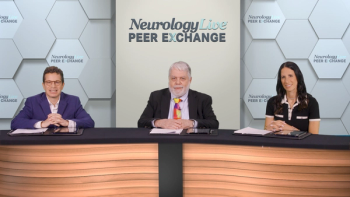
Erenumab Efficacious In Episodic Migraine Patients With Prior Treatment Failure
The study also added to a growing base of findings which suggest that patients who have failed preventive medications prior to trial participation have lower placebo responses, which could have implications for clinical trial design.
Peter J. Goadsby, MD, MBBS, PhD, DSc
New study data suggests that erenumab (Aimovig, Amgen/Novartis) can consistently show efficacy in patients with episodic migraine who fail other preventative treatments over the course of several months.1
Ultimately, 70 mg and 140 mg doses of erenumab in patients who had failed ≥2 prior preventive treatments reduced monthly migraine days (MMDs) by 1.3 (95% CI, 2.6-0.0; P <.05) and 2.7 (95% CI, 4.0-1.4; P <.001), respectively, compared with placebo. For patients who had failed ≥1 prior treatment, there were reductions of 2.0 MMDs (95% CI, 2.8-1.2; P <.001) and 2.5 MMDs (95% CI, 3.4-1.7; P <.001), respectively. For those who were preventive treatment-naïve, reductions of 0.9 MMDs (95% CI, 1.5-0.3; P <.05) for 70 mg and 1.3 MMDs (95% CI, 1.9-0.7; P <.001) for 140 mg were reported.
“Our prespecified and post hoc analyses support the utility of erenumab as a new and safe migraine preventive therapy for patients who have failed other preventive therapies,” Peter J. Goadsby, MD, MBBS, PhD, DSc, professor of neurology at both the University of California San Francisco and King’s College London, and colleagues wrote. “Moreover, the data contribute to a growing evidence base suggesting patients who have failed previous preventive medications have lower placebo responses, with important implications for clinical trial design in the future.”
The trial grouped patients by those randomized to erenumab in doses of 70 mg (n = 317) and 140 mg (n = 319) or placebo (n = 319). Overall, 42.4% of patients (405 of 955 patients) had previously received preventive treatment. Groups were sub-stratified based on the number of treatment failures. In the 70-mg, 140-mg, and placebo groups, the patient breakdown was the following:
- Placebo: ≥2 prior failures, 54; ≥1 prior failure, 127; no prior failure, 192.
- Erenumab 70 mg: ≥2 prior failures, 49; ≥1 prior failure, 127; no prior failure, 190.
- Erenumab 140 mg: ≥2 prior failures, 58; ≥1 prior failure, 116; no prior failure, 203.
Similar to the other findings, the monthly acute migraine-specific mediation days (MSMDs) were reduced in all 3 patient subgroups. For the patients who failed ≥1 treatment, MSMDs were reduced by 2.0 (95% CI, —2.8 to –1.2) and 2.5 (95% CI, –3.4 to –1.7) in the 70- and 140-mg groups, respectively. For those who failed ≥2 previous treatments, those reductions were by 1.3 (95% CI, –2.6 to 0.0) and 2.7 (95% CI, –4.0 to –1.4).
For those with no prior treatment failure, MSMDs were reduced by 0.9 (95% CI, —1.5 to –0.3) in the 70-mg group and 1.3 (95% CI, –1.9 to –0.7) in the 140-mg group.
“These results support that a lower placebo response might be achieved in migraine trials by including a sufficient proportion of patients who have tried and failed migraine preventives,” Goadsby and colleagues wrote. “Further analysis of recent trial data may provide further insights into factors contributing to a low or high placebo response.”
Similar results were observed in the achievement of 50% and 75% reduction in monthly migraine days. For the 50% reduction in monthly migraine day endpoint, placebo response in the no prior treatment failed group was 32.6%, while it was 17.5% in the 1 failed treatment group, and 11.1% in the 2 failed treatments group.
Recently, the FDA added a safety-related change to erenumab’s label to include a contraindication for patients with serious hypersensitivity to erenumab or to any of the excipients due to the risk of anaphylaxis and angioedema. The update noted that hypersensitivity reactions, “including rash, angioedema, and anaphylaxis” have been reported with the anti-calcitonin gene-related peptide (CGRP) treatment in its post-market time. It was originally approved by the agency in May 2018.2
As for adverse events (AEs), more than half of those without prior treatment failure (51.7% to 59.9%) and almost two-thirds of those with prior treatment failure experienced an AE (58.3% to 70.4%). The total percentage of patients who discontinued treatment due to AEs was between 0.0% and 6.9% across all treatment groups.
“The incidence of AEs for placebo compared to erenumab 70 mg and erenumab 140 mg was comparable within each subgroup,” Goadsby and colleagues detailed.
Serious AEs were experienced by 7 patients in the placebo group (no failed treatment, n = 6; ≥1 failed treatment, n = 1), 10 patients in the 70-mg group (no failed treatment, n = 4; ≥1 failed treatment, n = 4; ≥2 failed treatments, n = 2), and 9 patients in the 140-mg group (no failed treatment, n = 3; ≥1 failed treatment, n = 3; ≥2 failed treatments, n = 3).
“Erenumab had consistent efficacy across clinical endpoints in patients with episodic migraine across subgroups, although patients in the non-failed subgroup had a higher placebo response, which resulted in lower treatment differences,” the investigators concluded.
REFERENCES
1. Goadsby PJ, Paemeleire K, Broessner G, et al. Efficacy and safety of erenumab (AMG334) in episodic migraine patients with prior preventive treatment failure: A subgroup analysis of a randomized, double-blind, placebo-controlled study. Cephalalgia. Published online April 13, 2019. doi: 10.1177/0333102419835459.
2. Aimovig [FDA label update]. Updated March 11, 2019. accessdata.fda.gov/scripts/cder/safetylabelingchanges/index.cfm?event=searchdetail.page&DrugNameID=1894. Accessed March 13, 2019.
Newsletter
Keep your finger on the pulse of neurology—subscribe to NeurologyLive for expert interviews, new data, and breakthrough treatment updates.









































